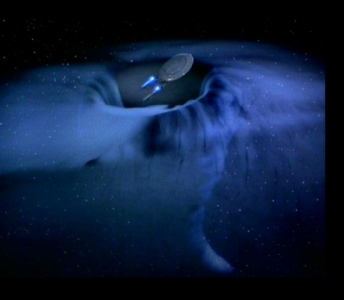|

In Star Trek, an energy vortex was a spinning, turbulent
local temporal continuum anomaly comprised of pure energy that occurred
in space. In 2365, the USS Enterprise-D encountered an energy vortex
near the Endicor system. According to Data, the encounter with the
vortex revealed that was "similar in function to our tractor beam, only
more powerful." The Enterprise tried to escape the gravitational force
of the vortex, only to discover that it was unable to escape the pull
while traveling at maximum warp. In an attempt to save the Enterprise,
Picard decides to leave the ship aboard the shuttlepod El-Baz, to
distract its attention long enough to allow the Enterprise to escape.
The Enterprise was destroyed in the vortex but was thrown back in time
six hours. After the Enterprise encountered the future Picard, it
experienced the encounter with the vortex once again, only with a
different outcome. Picard stopped his future self from leaving the
Enterprise and turned the ship into the vortex, freeing the ship from
it, and allowing it to resume course to the Endicore system. (TNG:
"Time Squared")
The effects of that energy vortex - strong gravitational
fields and the ability to travel through time - appear to be similar to
effects one would find near a black hole. According to Einstein's
theory of general relativity, in the presence of a gravitational field,
an external observer would see a clock in a strong gravitational field
tick more slowly. If you were traveling into a strong gravitational
field and sending out pulses of light every second, an observer
watching these signals from a great distance would see the interval
between the pulses increase from seconds to minutes and then hours as
the field got stronger and stronger.
Black holes are fantastic sources of very strong
gravitational fields. What a distant observer would see as your clock
got closer to the so-called Event Horizon of the black hole is that the
pulse interval would increase without limit from one second to one
month and longer. The frequency of the light pulses would also get
longer as the light lost more and more energy struggling to get out
from the vicinity of the black hole. As your friend finally entered the
black hole by passing across its event horizon, the last photon capable
of making it to infinity is emitted at almost infinite redshift,
meaning that if you originally emitted a gamma ray with an energy of
1000 billion electron volts, buy the time your friend received it far
away, it would have lost enough energy to become a radio photon with an
energy of 0.00001 electron volts! So, if it took your friend 1000 hours
to travel from where you are to the black hole, the last photon he sent
you just before entering the black hole, would arrive at your location
1000 hours from now, but when you looked at the interval between the
last two pulses he sent, you would see that they are not the one second
interval you started out with, but say 1 or 2 minutes or more. But
here's the rub. According to your infalling friend, he/she is still
sending the pulses out once each second!
In other words, one second to your friend falling into a
black hole is several minutes to you and, in essence, your friend is
aging more slowly than you and is traveling into the future faster than
you are. To your friend, only 2000 hours may have elapsed, however,
YOUR clock would read perhaps 10000 hours or several weeks have elapsed
depending how close to the Event Horizon your friend could get before
escaping.
The tidal gravitational forces are enormous near small
black holes the mass of the sun, so your friend would be shredded into
spaghetti within a few hundred miles of the Horizon. For supermassive
black holes of several billion solar masses, however, the tidal forces
near the Horizon are very small and survivable. This means you could
accidently find yourself passing across this one-way barrier, and only
realize your mistake when you tried to escape and found it impossible.
In principle, if you could get within a few millimeters of an Event
Horizon before escaping, you could essentially time travel years or
millenia into the future as measured by outside clocks. According to
your clock, however, perhaps only a few hour or days actually elapsed.
|
|
